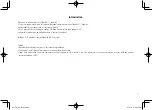
Applications Guide
Networking
A-8
Strata CIX Programming Vol.1 12/09
Networking
Strata CIX enables networking of resources using Strata Net Private Networking. Read the following
discussion through before programming Strata CIX networking features.
Strata Net Private Networking
The Strata CIX introduces robust private networking, Strata Net, to the Toshiba family of
telecommunications products. Based on an international standard, QSIG, Strata Net will allow multiple
Strata CIX systems to share voice mail systems and attendants, share features and a coordinated
numbering plan and route calls simply and easily throughout the enterprise. Strata Net is distinguished
from CIX Basic Networking which provides interconnection of nodes through conventional, E&M Tie lines.
QSIG
Toshiba has adopted QSIG as the basis for Strata Net. QSIG is an open, international standard for
networking PBXs. It was begun in 1994 with a memo of understanding between twelve leading PBX
manufacturers. The QSIG Handbook can be found on the web at
http://www.QSIG.ie/
. The standards were
developed and are maintained by the European Computer Manufacturers Association (ECMA), an
international, Europe-based industry association founded in 1961 and dedicated to the standardization of
information and communication systems. ECMA may be found on the web at
http://www.ecma-international.org
.
QSIG is an intelligent and powerful signaling system, providing great flexibility in terms of network
architecture. Any network node can establish routes to 128 other nodes and segmented networks can
grow beyond that. New nodes can be added to the network as business needs dictate. The use of QSIG
does not impose the use of a specific network topology and it can be used with any network configuration:
meshed, star, main and satellite, etc.
Toshiba, like most of its competitors, has chosen to implement QSIG over Primary Rate Interface. Strata
Net supports QSIG Basic Call Control that allows it to interoperate with other PBXs that conform to the
QSIG standard.
Node ID
The basic logical element in Strata Net routing is the node ID. It functions similarly to the address in a
packet data network. As a call is routed through the network, each node examines the leading received
digits for a node ID defined in its flexible numbering plan. After first discerning a node ID, the Strata CIX
then determines whether the node ID is for itself or for a remote node. If it is a remote node ID, the call
goes through a routing process that selects an OLG, manipulates the digits and sends the call to the next
node in the network. If the call contains the local node ID, the Strata CIX manipulates the number
according to the overlap code and delivers the call to a local station, trunk or feature.
The node ID is one to six digits long. The Strata CIX knows that a node ID to which an overlap code has
been assigned is for the local node and that all others are for the remote nodes.
Strata Net bases its routing decisions exclusively on the node ID and makes no attempt to analyze or
restrict the remaining dialed digits. These remaining digits are not processed until delivered to the
destination Strata Net node. This provides a simple, powerful tool because the programmer does not need
to consider local conditions in transit nodes and does not need to fear interference with the call regardless
of the path it takes through the network.
Network Directory Number
A Network Directory number consists of two elements: the node ID and the local directory number. A node
ID is a string of 1 to 6 digits that identifies one node on the network. A network DN may be a simple
concatenation of the two elements in which the complete node ID precedes the complete extension or the
Summary of Contents for CIX 200
Page 42: ...Network eManager 2 4 Strata CIX Programming Vol 1 12 09 ...
Page 43: ...Network eManager Strata CIX Programming Vol 1 12 09 2 5 Network eManager ...
Page 44: ...Network eManager 2 6 Strata CIX Programming Vol 1 12 09 ...
Page 314: ...This page is intentionally left blank ...
Page 432: ...This page is intentionally left blank ...
Page 434: ...This page is intentionally left blank ...
















































